Why Body-Cooler- Solutions Are Critical for Safety and Comfort
Body-cooler- systems provide essential temperature regulation for both human remains storage and personal thermal comfort, serving critical roles in funeral homes, hospitals, and everyday heat management scenarios.
Quick Body Cooler Solutions Overview:
- Mortuary Coolers: 2-12 body capacity units ($6,095-$15,975) with 15-year warranties
- Wearable Cooling: Phase-change vests, thermoelectric devices, evaporative textiles
- Personal Devices: Neck fans, cooling towels, palm-grip coolers ($200-$500)
- Walk-in Systems: Custom-sized refrigeration for high-capacity storage
Whether you need reliable cadaver storage that plugs into standard 110V outlets or wearable cooling technology that drops surface temperature by 20 degrees in minutes, the right body-cooler- solution depends on your specific application, space constraints, and budget requirements.
From rural county morgues requiring self-contained 4-body upright units to individuals managing heat intolerance with cooling accessories, these systems use proven technologies like evaporative cooling, phase-change materials, and thermoelectric plates to maintain safe temperatures without complex installation requirements.
I'm Mortuary Cooler, a national-level mortuary cooler supplier specializing in body-cooler- solutions for funeral homes, hospitals, and medical facilities across the United States.
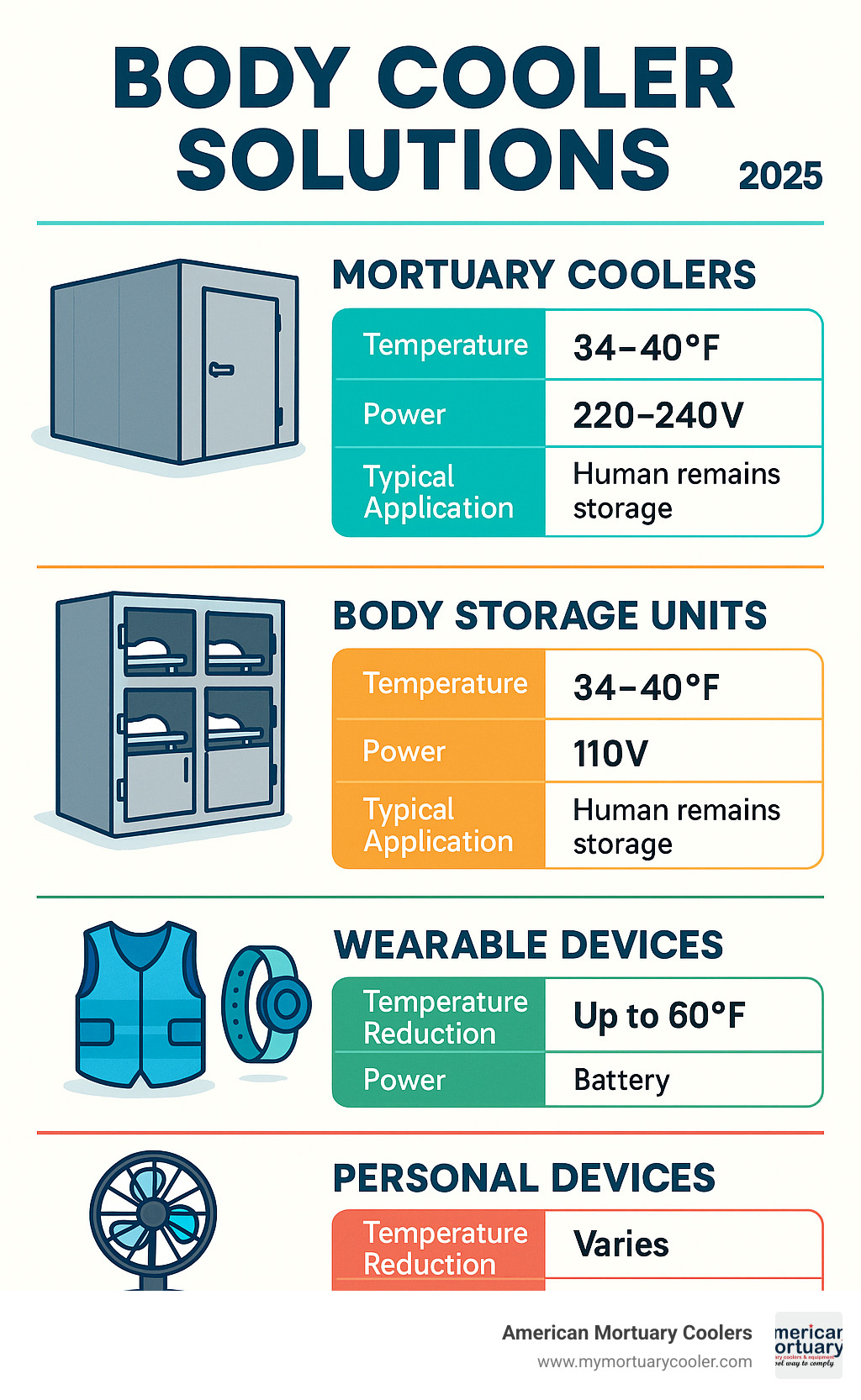
Basic body-cooler- vocab:
What Is a Body Cooler and How Does It Keep You Safe?
Think of a body-cooler- as your temperature guardian angel. Whether you're a funeral director needing to preserve human remains with dignity or someone dealing with heat intolerance on a sweltering summer day, these devices are all about one thing: keeping temperatures exactly where they need to be.
At its heart, every body-cooler- works through three basic heat transfer methods. Conduction happens when something cool touches your skin directly - like placing a cold pack on your wrist. Convection is all about air movement, like a fan blowing across your body. Evaporation mimics what your body does naturally when you sweat, using moisture to carry heat away.
For funeral homes and medical facilities, body coolers maintain precise temperatures to prevent decomposition and ensure families can say their goodbyes with dignity. Personal cooling devices have become lifesavers for millions dealing with heat intolerance.
The Science Behind Body-Cooler- Technology
Your body runs its own sophisticated cooling system, with your hypothalamus acting like a biological thermostat. When things heat up, this brain region triggers vasodilation - your blood vessels widening near the skin surface. This increases skin blood flow, helping heat escape from your core.
Body-cooler- devices work with this natural process, not against it. They accelerate heat transfer from your skin surface and support your body's evaporative cooling through sweat. The smartest designs target specific areas with high blood flow - your neck, wrists, and palms are cooling goldmines.
The most effective personal cooling devices focus on what scientists call glabrous skin areas. These spots on your palms, soles, and face contain special blood vessels designed for rapid heat exchange.
Typical Users and Use-Cases
Hospitals rely on body coolers for temporary storage of human remains, patient fever management, and maintaining proper operating room temperatures.
Funeral homes represent the largest user group for mortuary body-cooler- systems. They need reliable cadaver storage before services, cooling systems for transport vehicles, and climate control in preparation rooms.
Athletes have found that strategic cooling before competition can actually improve performance. Recovery cooling between training sessions helps prevent heat exhaustion.
MS patients and others with heat sensitivity use personal cooling devices for daily symptom management. Many find that consistent cooling improves sleep quality and helps maintain mobility even in hot environments.
Outdoor workers - from construction crews to emergency responders to industrial workers - face temperature extremes as part of their daily routine. Personal body-cooler- devices can mean the difference between productive work and dangerous heat stress.
The Main Categories of Body-Cooler- Solutions
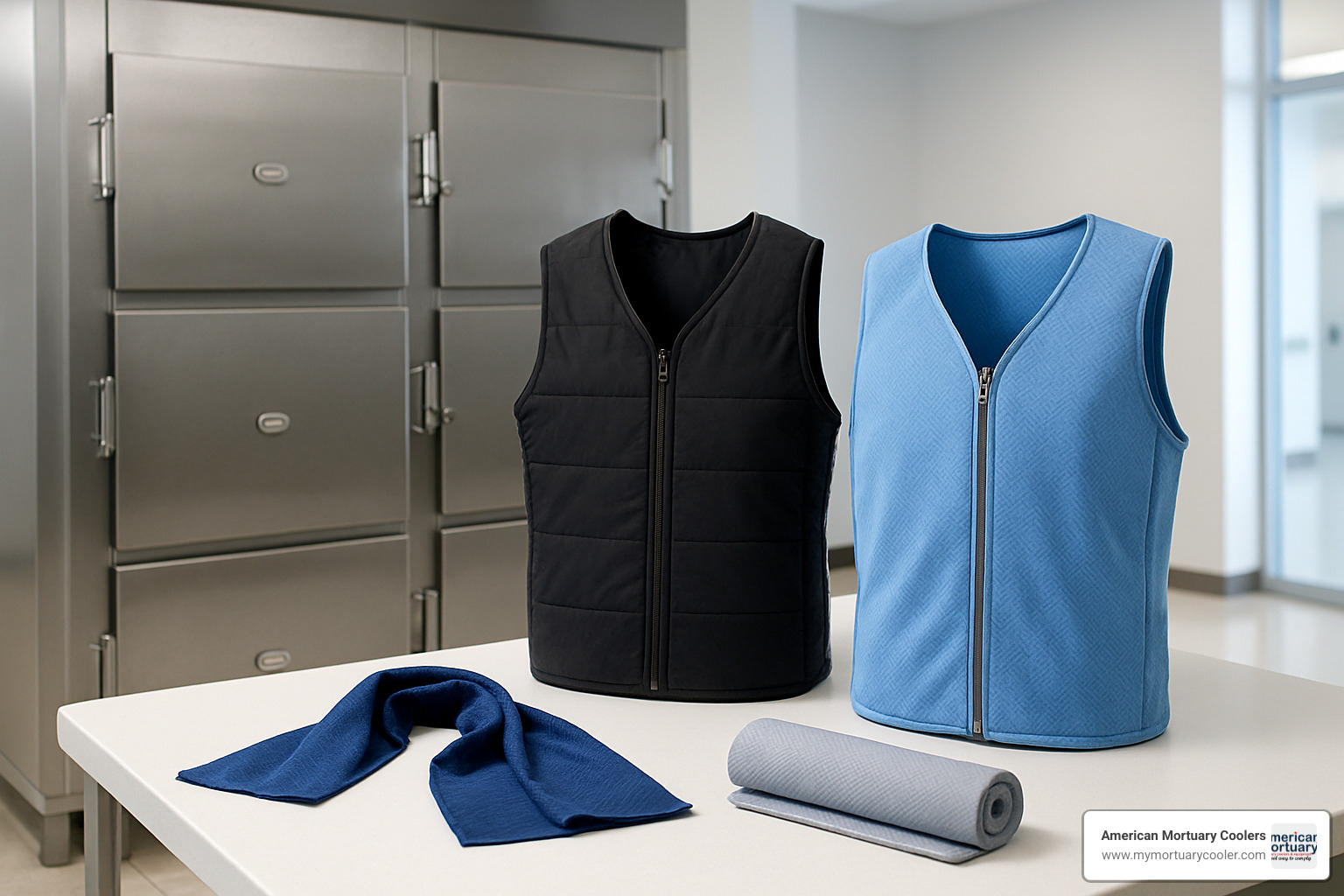
The body-cooler- market divides into two primary categories: mortuary refrigeration systems for cadaver storage and personal cooling devices for living individuals. Each category uses different technologies optimized for specific temperature requirements and usage patterns.
Mortuary coolers range from compact 2-body units to large walk-in systems, while personal devices span from simple cooling towels to sophisticated thermoelectric wearables. Understanding these categories helps you choose the right solution for your specific needs.
Mortuary Body Coolers at a Glance
Mortuary body-cooler- systems maintain human remains at safe storage temperatures, typically between 35°F-41°F. These units come in several configurations:
Upright Units: The most common design, with bodies stored vertically on rolling racks. Available in 2, 3, 4, 6, and 12-body capacities. The 4-body upright cooler is particularly popular for rural county morgues and smaller funeral homes, starting at $9,199.
Side-Load Coolers: Allow horizontal loading, ideal for facilities with limited ceiling height or specific workflow requirements.
Roll-In Style: Designed for easy transport of remains on gurneys or stretchers, minimizing manual lifting.
Walk-In Systems: Custom-built refrigerated rooms for high-capacity storage, popular in large medical facilities and busy funeral homes.
All mortuary coolers feature self-contained refrigeration systems requiring no drainage, digital temperature controllers, and heavy-duty construction with extended warranties - typically 15 years on panels and doors, 5 years on mechanical components.
Wearable & Personal Devices for Everyday Relief
Personal body-cooler- devices focus on immediate comfort and heat stress prevention for living individuals:
Cooling Vests: Use phase-change materials, evaporative textiles, or circulating water systems. Popular among outdoor workers and individuals with heat-sensitive medical conditions.
Thermoelectric Devices: Battery-powered units like wristbands that use electronic cooling plates to create warming or cooling sensations, influencing whole-body temperature perception.
Evaporative Accessories: Water-activated cooling towels, neck wraps, and clothing that use moisture evaporation for sustained cooling relief.
Portable Fans: Neck-mounted or handheld devices providing targeted airflow, particularly effective when combined with evaporative cooling methods.
Deep Dive: Mortuary Body-Cooler- Systems
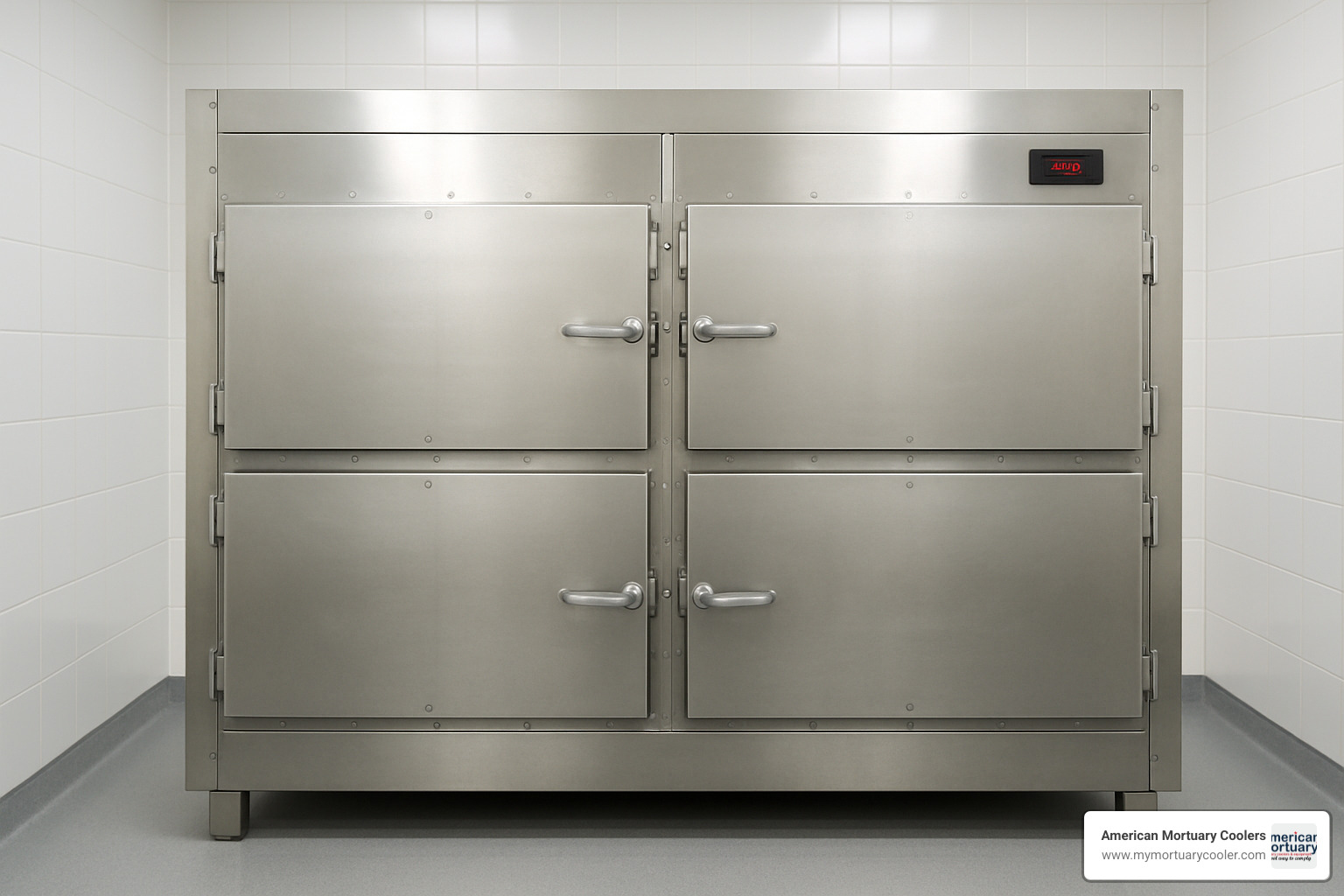
When you're shopping for a mortuary body-cooler- system, you're not just buying a refrigerator. These units are purpose-built for the unique challenges of human remains storage, with features that would be complete overkill for storing food but are absolutely essential for maintaining dignity and safety in funeral service.
The most popular choice among funeral directors is the 4-body upright unit. Picture this: a sleek, professional-looking cooler that plugs into any standard wall outlet, assembles with simple cam-lock panels (no contractor needed), and operates as a completely self-contained system. No plumbing hookups, no special electrical work, no drainage requirements.
These units measure about 8 feet deep by 4 feet wide and just under 8 feet tall with the cooling unit and casters. Inside, you get a spacious 86.5" x 36" x 75" storage area with a 4-tier roller rack system that makes access smooth and respectful. The digital thermostat keeps everything at the perfect temperature without the guesswork of older analog controls.
These coolers qualify for Section 179 tax benefits and meet EISA 2007 energy standards. That means potential immediate tax write-offs and lower utility bills.
| Assembled vs. Unassembled Models | Assembled | Unassembled |
|---|---|---|
| Delivery | Requires forklift/dock | Hand-carried pieces |
| Setup Time | Ready to use | 1.5-2 hours assembly |
| Shipping Cost | Higher freight | Lower shipping rates |
| Doorway Access | May not fit through doors | Fits through standard doors |
Key Features & Specs You Should Demand
Not all mortuary coolers are created equal. The insulation R-value is your best friend when it comes to energy efficiency and temperature stability.
Quality units use expanded polystyrene insulation without any wood components. Wood can warp, harbor moisture, and create thermal bridges that waste energy. The best coolers maintain temperatures within ±2°F of your setpoint.
Rack capacity matters more than you might think. Standard widths of 23", 27", or 30" accommodate different cot sizes, but telescoping rails make the real difference in day-to-day use.
The temperature range should cover your needs completely, typically from 35°F to 41°F for standard storage. Digital controls aren't just fancy - they're more accurate and reliable than old-style dial thermostats.
Don't settle for anything less than a 15-year warranty on panels and doors, with at least 5 years on mechanical components.
Shipping, Installation & Compliance Checklist
Getting your new body-cooler- delivered and set up properly is easier than most people expect. If you're getting an assembled unit, you'll need forklift access or a loading dock.
For facilities without dock access, unassembled units are a game-changer. The cam-lock panels snap together with basic tools, and you can carry all the pieces through a standard doorway.
Your location needs to stay below 95°F ambient temperature. Code compliance varies by location, but UL and NSF certifications are non-negotiable. ASTM E84 flame spread ratings ensure fire safety compliance.
The electrical requirements are refreshingly simple - standard 110V plug operation means no expensive electrical upgrades for most facilities.
Price Bands & Financing Options
Mortuary body-cooler- pricing reflects the specialized nature of these units. 2-body units start around $6,095 for basic configurations. The sweet spot for most funeral homes is the 4-body upright range, typically $9,199 to $12,000. 12-body units and larger systems can reach $15,000 or more.
Section 179 tax write-offs can let you deduct the entire purchase price in the year you buy, assuming your total equipment spending stays under $2 million annually. Modern body-cooler- systems use significantly less electricity while maintaining better temperature control.
Wearable & Portable Body-Cooler- Technologies
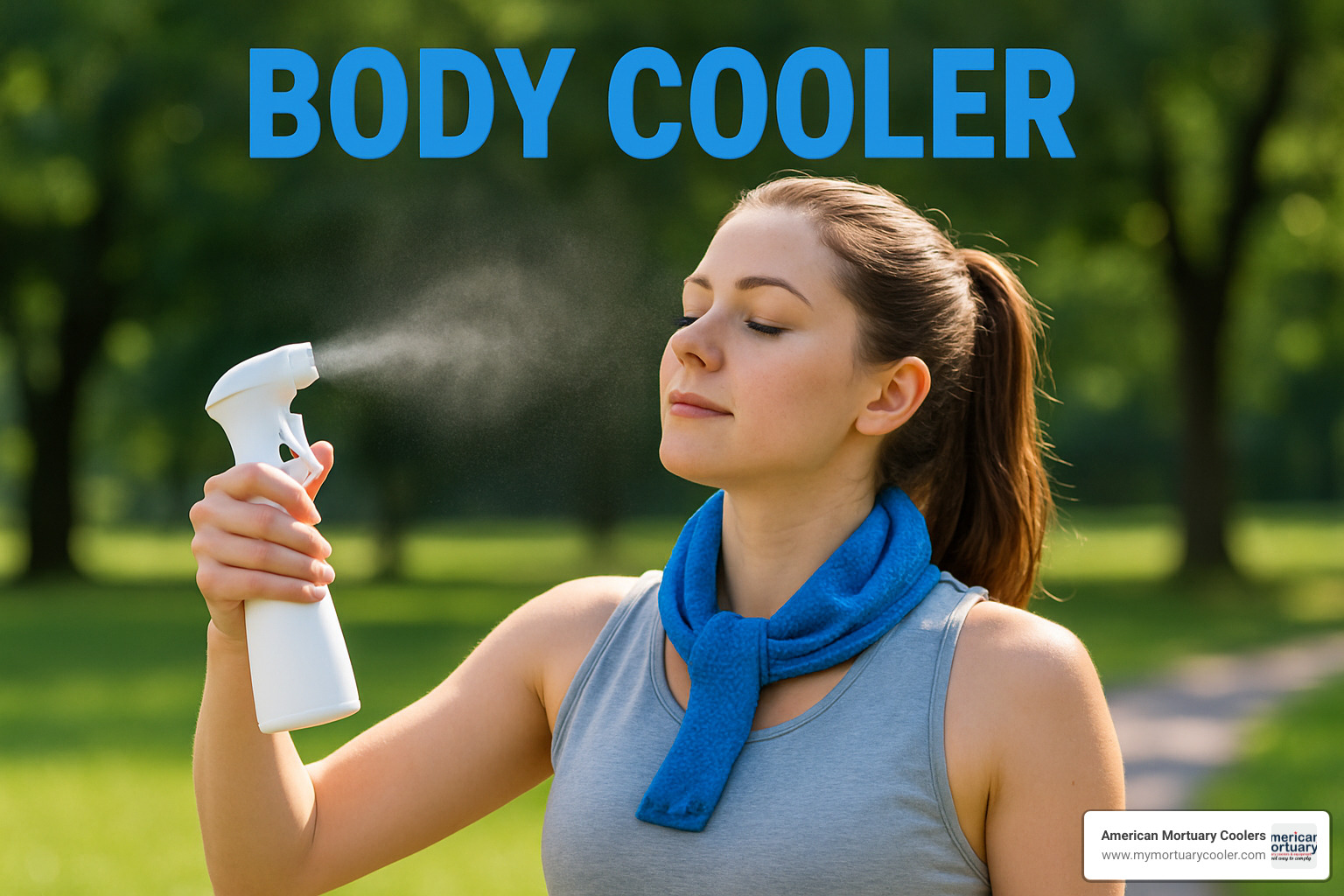
Personal body-cooler- devices have evolved dramatically, incorporating advanced materials science and electronics to provide effective temperature relief without the bulk and inconvenience of traditional cooling methods.
Modern wearable cooling technologies fall into four main categories:
Phase-Change Materials: Cool 58® packs freeze at 58°F and provide consistent cooling for 1-2 hours. They can be activated in ice water in approximately 15 minutes when freezers aren't available.
Water-Based Cooling Packs: Kool Max® frozen packs require freezer charging but deliver the highest cooling energy for up to 2 hours.
Evaporative Cooling Textiles: Advanced fabrics like COOLINE SX3 can bind 10 times their weight in water and provide up to 660 watts of cooling power through moisture evaporation. These systems are completely climate-neutral, using only water and air.
Thermoelectric Devices: Battery-powered units like the Embr Wave use precisely engineered thermal sensations on the wrist to influence whole-body temperature perception. Users report feeling 5°F cooler on average after just three minutes of use.
The sustainability advantage of modern cooling textiles is remarkable - they save over 90% CO₂ compared to air conditioning while providing localized cooling that can be more effective than room-wide temperature control.
Choosing the Right Tech for Your Environment
Environmental conditions significantly impact body-cooler- technology effectiveness:
High Humidity Environments:
- Phase-change packs perform consistently regardless of humidity
- Evaporative cooling becomes less effective above 70% relative humidity
- Thermoelectric devices maintain performance in all humidity conditions
Limited Freezer Access:
- Phase-change packs activate in ice water within 15 minutes
- Evaporative textiles need only tap water for activation
- Battery-powered devices eliminate infrastructure requirements
Extended Use Requirements:
- Circulating water systems offer continuous cooling for 12+ hours
- Rechargeable thermoelectric devices run 3-4 hours on a single charge
- Phase-change packs typically last 1-2 hours per activation cycle
Care, Cleaning & Longevity Tips
Proper maintenance extends the life of body-cooler- devices:
Evaporative Cooling Garments:
- Wash separately at 30°C on wool or hand-wash cycle
- Use pH-neutral detergents to preserve cooling function
- Air dry to maintain fabric integrity
Phase-Change and Water-Based Packs:
- Inspect regularly for leaks or punctures
- Store in cool, dry locations when not in use
- Replace packs showing signs of wear
Electronic Cooling Devices:
- Charge batteries fully before extended use
- Clean cooling plates with soft, damp cloth only
- Store devices at room temperature when not in use
Green Cooling: Environmental Impact & End-of-Life
Modern body-cooler- technologies increasingly focus on environmental sustainability:
Refrigerant-Free Systems: Most personal cooling devices avoid traditional refrigerants, eliminating ozone depletion and global warming potential concerns.
Energy Efficiency: Localized cooling reduces overall energy consumption compared to air conditioning. Battery-powered devices use minimal electricity.
Water Conservation: While evaporative cooling uses water, the amounts are minimal compared to traditional cooling systems. A typical cooling vest uses less than a liter of water per day.
End-of-Life Considerations: Phase-change materials are typically non-toxic and recyclable. Electronic components should be recycled through e-waste programs.
Smart Buying & Maintenance Checklist
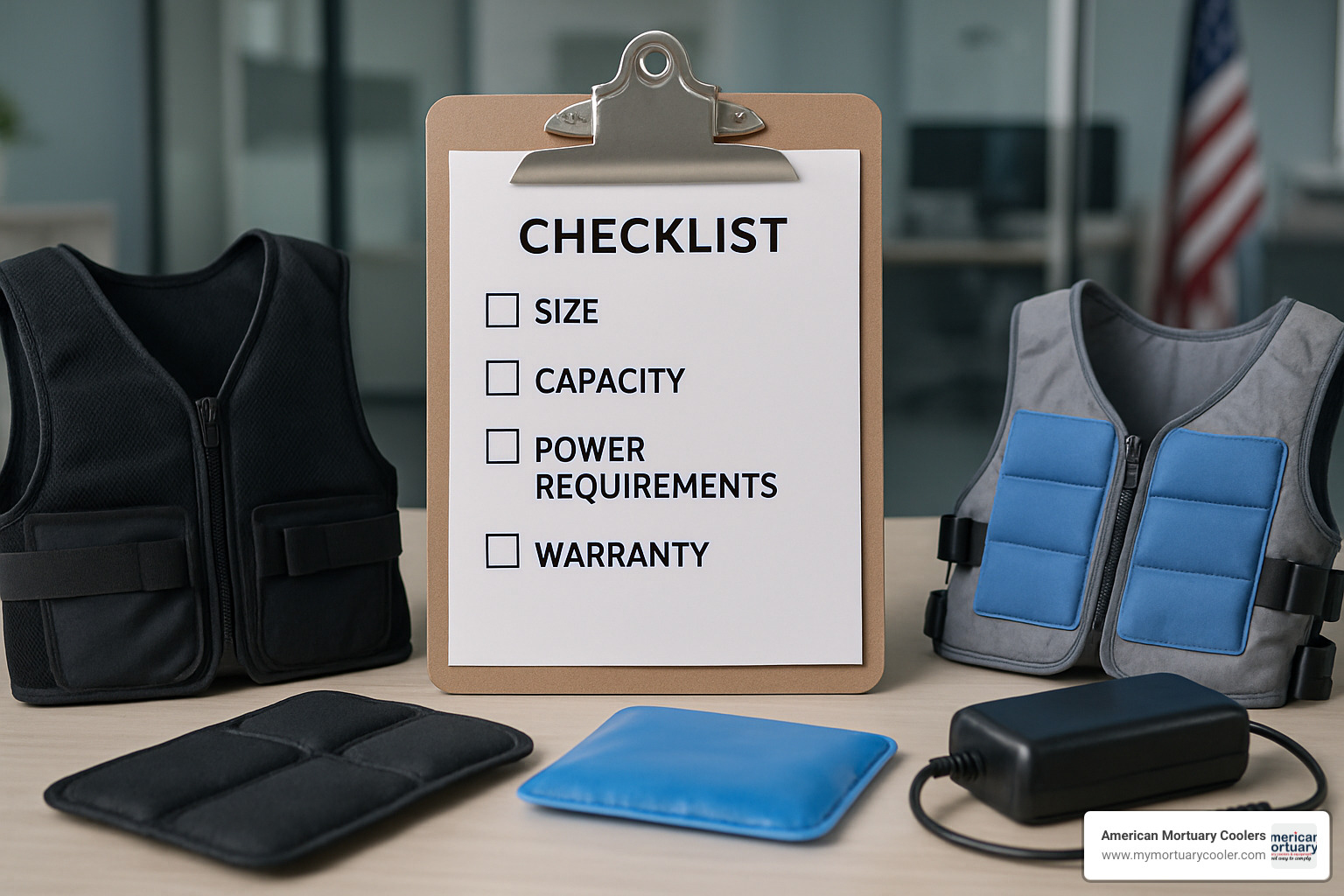
Choosing the right body-cooler- doesn't have to feel overwhelming. After helping funeral homes and facilities across the country for years, we've learned that the best decisions come from asking the right questions upfront.
Start with your space reality. Measure twice, buy once really applies here. That 4-body upright cooler might look perfect online, but if it won't fit through your prep room door, you've got a problem. Consider ceiling height, door clearances, and room for the condensing unit to breathe properly.
Power planning prevents problems. Most modern body-cooler- units plug into standard 110V outlets, which makes life easier. But double-check your electrical capacity, especially if you're adding a unit to an older building.
Think about your busiest days, not your average ones. That 2-body unit might handle most weeks fine, but what happens during flu season or holiday weekends? Planning for peak capacity from the start costs less than upgrading later. For more guidance on this, check out optimizing body cooler storage efficiency.
Don't forget the human factor. The best cooling system is worthless if your staff can't operate it comfortably. Consider things like door swing direction, rack height, and control placement.
Budget & ROI Planning
Body-cooler- investments range dramatically, from around $200 for personal cooling devices all the way up to $15,000 or more for large mortuary systems. But the sticker price is just the beginning of the story.
The sweet spot for most funeral homes sits in that $9,000 to $15,000 range for a quality 4-6 body mortuary cooler. Yes, it's a significant investment, but consider what you're really buying - peace of mind, regulatory compliance, and the ability to serve families with dignity.
Section 179 tax savings can make a huge difference in your actual cost. If your business spends under $2 million annually on equipment, you can potentially write off the entire purchase in the same tax year. That $12,000 cooler might effectively cost you $8,000 or less after tax benefits.
Operating costs stay surprisingly reasonable. Most mortuary coolers run about $50-200 monthly in electricity. Most facilities find their investment pays for itself within 2-3 years through improved efficiency, reduced emergency service calls, and better service capabilities.
Future-Proof Features to Look For
Technology keeps advancing, even in the mortuary cooling world. While you don't need every bell and whistle, some features will keep your investment valuable for years to come.
Modular panel construction represents one of the smartest advances in body-cooler- design. These cam-lock systems let you expand capacity later without starting over completely.
Digital controls and monitoring might seem like overkill now, but they're becoming standard for good reasons. Remote alerts can notify you of temperature issues before they become disasters.
Energy efficiency features pay dividends over time. Variable-speed compressors adjust cooling output to actual needs rather than running full-blast constantly.
Service-friendly design matters more than most people realize initially. Look for units with easy access to serviceable components and clear diagnostic systems.
Frequently Asked Questions about Body-Cooler- Solutions
People often ask us about the differences between various cooling systems and what they need to know before making a purchase. Here are the questions we hear most often from funeral directors, medical facilities, and individuals looking for personal cooling solutions.
How does a mortuary body cooler differ from a walk-in food cooler?
While both maintain similar temperatures, mortuary body-cooler- systems are purpose-built for human remains storage with critical differences that make food coolers unsuitable for funeral home use.
The temperature story is more complex than it first appears. Yes, both maintain temperatures around 35°F-41°F, but mortuary coolers require much tighter temperature stability. Food can handle a few degrees of fluctuation - human remains cannot. Our mortuary units maintain temperature within ±2°F to prevent tissue damage and ensure dignity.
Interior design makes all the difference. Food coolers use basic shelving designed for boxes and containers. Mortuary coolers feature specialized racking systems with proper spacing and weight support for human remains.
Sanitary requirements go far beyond food service standards. Mortuary coolers include seamless interior surfaces, antimicrobial coatings, and design features that make thorough cleaning and decontamination possible.
Regulatory compliance varies significantly by application. Health departments have specific requirements for human remains storage that are generally more stringent than food service regulations.
What cooling technology lasts longest in high humidity?
High humidity above 70% dramatically affects how different body-cooler- technologies perform, and understanding this can save you from choosing the wrong solution for your environment.
Phase-change materials are your best friend in humid conditions. These systems maintain consistent performance regardless of ambient humidity because they don't rely on evaporation. Cool 58® packs provide the same cooling duration whether you're in Arizona or Louisiana.
Circulating water systems and thermoelectric devices also shine in humid environments. They provide reliable cooling that's completely independent of environmental moisture.
Evaporative cooling struggles when the air is already saturated. Cooling towels and water-activated textiles that work wonderfully in dry climates provide minimal relief when the air can't absorb more moisture.
The smart approach combines technologies for humid conditions. Use phase-change packs with circulating air systems, or pair thermoelectric devices with moisture-wicking fabrics.
Are there safety standards my new body cooler must meet?
Absolutely, and these standards exist for good reasons. Body-cooler- systems must comply with multiple safety and regulatory requirements that protect both users and the public.
Electrical safety comes first. All electrical components must carry UL (Underwriters Laboratories) listing, which means they've been tested for fire and shock hazards. Proper grounding and circuit protection aren't optional - they're required.
Sanitary standards ensure public health protection. NSF/ANSI Standard #7 certification for commercial refrigeration is standard, along with FDA compliance for equipment that contacts human remains.
Building and fire codes apply to all commercial refrigeration. ASTM E84 flame spread and smoke development ratings ensure your equipment won't contribute to fire hazards.
Environmental regulations cover refrigerant handling and energy efficiency. EPA requirements govern how refrigerants are handled during installation and service. EISA energy efficiency standards ensure your equipment meets federal energy requirements.
Professional installation is usually required by law. Most jurisdictions require licensed refrigeration contractors for installation and initial startup. We strongly recommend using factory-authorized installers.
Conclusion & Next Steps
Choosing the right body-cooler- solution doesn't have to be overwhelming. Whether you're running a small funeral home that needs reliable cadaver storage or you're someone dealing with heat sensitivity who needs personal cooling relief, the key is understanding your specific needs and matching them to the right technology.
From our experience at American Mortuary Coolers, we've seen how the right cooling system transforms operations. A rural funeral home that upgrades from unreliable refrigeration to a modern 4-body upright cooler gains peace of mind and professional capability. An outdoor worker who finds phase-change cooling vests can work safely through summer heat waves.
The body-cooler- industry has come a long way. Today's mortuary coolers plug into standard outlets, require no drainage, and come with 15-year warranties. Personal cooling devices use space-age materials and smart electronics to provide relief that was unimaginable just a few years ago.
Getting started is straightforward. First, be honest about your capacity needs - both current and future. That compact 2-body cooler might seem perfect today, but if your facility is growing, you'll appreciate having invested in a 4-body unit instead. For personal cooling, consider your environment. High humidity areas need different solutions than dry climates.
Next, think about your infrastructure. Most modern mortuary coolers work with standard electrical service, but it's worth verifying before you buy. Personal devices are even simpler - most just need water or a standard wall outlet for charging.
Budget planning makes the difference between a smart purchase and buyer's remorse. Section 179 tax benefits can essentially make that mortuary cooler purchase free money for qualifying businesses. Personal cooling devices often pay for themselves quickly through improved comfort and productivity.
Your investment in proper cooling technology delivers benefits that go beyond just temperature control. Funeral homes gain operational reliability and professional capability. Individuals gain comfort, safety, and often improved health outcomes. The energy savings and long-term durability make these systems smart financial decisions too.
Ready to move forward? Start by measuring your space and calculating your needs. Then reach out to discuss your specific situation. Every cooling challenge has a solution - it's just a matter of finding the right match.
For detailed guidance on selecting and optimizing your cooling system, check out our comprehensive resources on effective body cooling solutions and optimizing storage efficiency.
The right body-cooler- solution is out there. With proper planning and the right guidance, you'll have reliable cooling that serves you well for years to come.
















